The Buckeye State is located in the midwestern region of the United States. Its three largest metropolitan areas are Greater Cleveland, Greater Cincinnati, and the Columbus metro area. It is the seventh state in terms of population and the tenth state in terms of population density.
Ohio consists of five different geographic regions – the Appalachian Plateaus, the Glaciated Allegheny Plateaus, the Till Plains, the Huron-Erie Lake Plains, and the Bluegrass Section spread across the state’s interior low plateau.
It is a fairly warm state, with moderate-high and low temperatures. As a result, plenty of flora and fauna species have made Ohio their home. In the following lines, you’ll learn more about some native plants of the Buckeye State!
What Is a Native Plant?
A plant can be described as native when it has lived and grown naturally in a certain area or region for thousands of years and has adapted to perfection to its soil conditions, climate, light, and so on. Such a plant is essentially a part of a region’s ecosystem and not only fits but also thrives there.
Native plants are also called indigenous, just like in the case of indigenous people throughout the world.
9 Native Plants in Ohio
1. Ohio Goldenrod
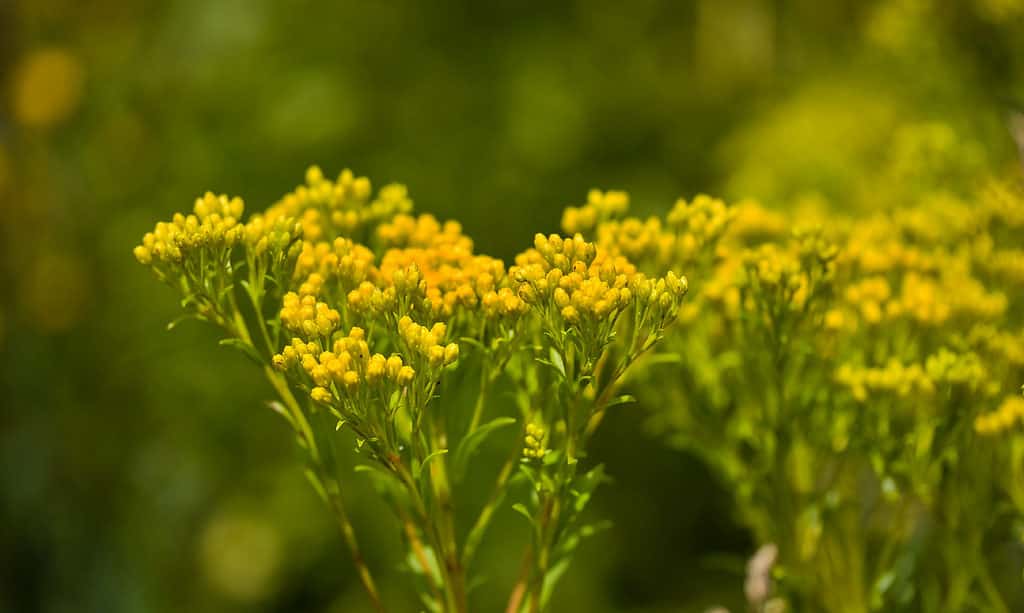
The Ohio goldenrod is part of the
Asteraceaefamily.
©islavicek/Shutterstock.com
| Ohio Goldenrod | |
|---|---|
| Scientific name | Solidago ohioensis |
| Type of plant | Perennial |
| Distribution | Great Lakes Region, United States (Michigan, Wisconsin, Indiana, Illinois, New York, Ontario, Ohio) |
The Ohio goldenrod is part of the Asteraceae family and is native to the Great Lakes region in the United States and Canada. Even though the plant is slim and can be easily missed while growing, the yellow flower head resembling a bouquet is easy to spot.
The Ohio goldenrod can grow up to 39 inches (100 cm) tall and features narrow leaves of about 10 inches (25 cm). The flowers grow in a branching array and are a rather impressive feat of nature! Each specimen of Ohio goldenrod can produce up to 500 yellow flower heads.
You can spot this plant if you trek in and around dunes, marshes, and river banks.
2. Yellow Trout Lily
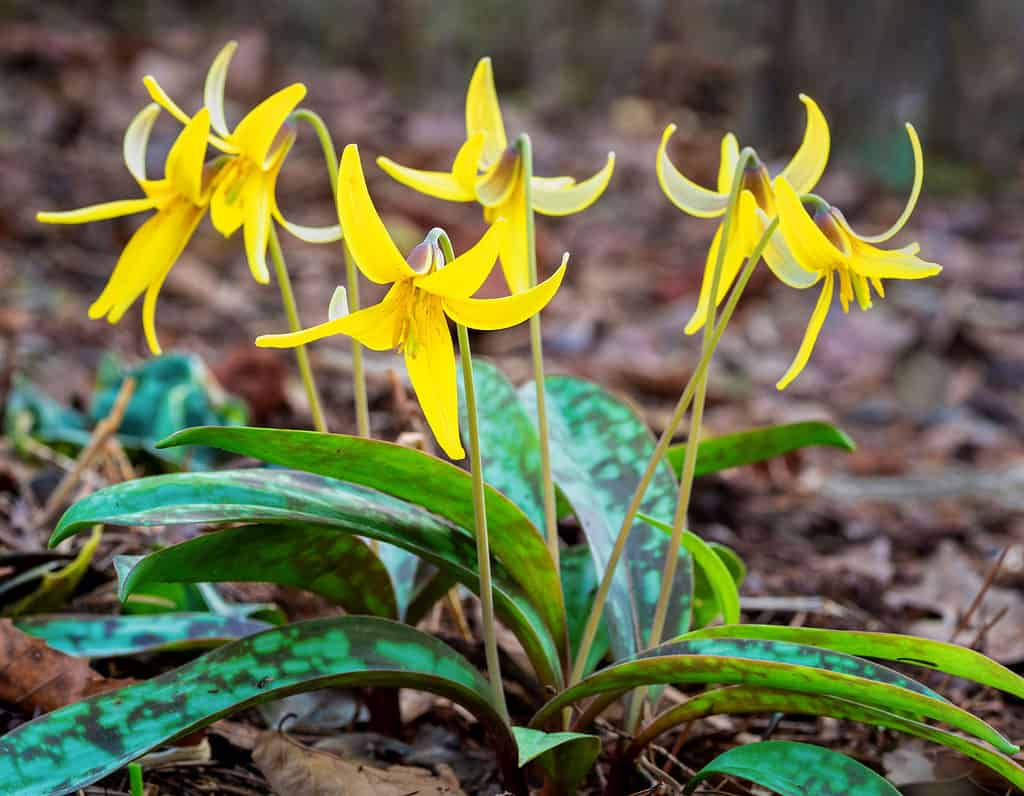
Yellow Trout Lily is a perennial plant native to North America that forms colonies.
©Gerry Bishop/Shutterstock.com
| Yellow Trout Lily | |
|---|---|
| Scientific name | Erythronium americanum |
| Type of plant | Perennial |
| Distribution | North America |
Often called yellow dogtooth violet or simply trout lily, the yellow trout lily is a perennial plant native to North America that forms colonies. It is also known as a spring ephemeral flower, meaning it has a short life cycle – the yellow trout lily emerges and blooms quickly in the spring.
In North America, the yellow trout lily is mainly found in woodland habitats. You can recognize it by its yellow flower with lanceolate tepals that grow on erect stalks. Each tepal is about 0.7-1.2 inches (20-33 mm) and features three sepals and three petals.
If you happen to come across a flowerless Erythronium americanum in early spring, remember that the species doesn’t flower in the first 4-7 years. According to statistics, only 0.5% of the plants in a colony bear flowers.
3. Butterfly Weed
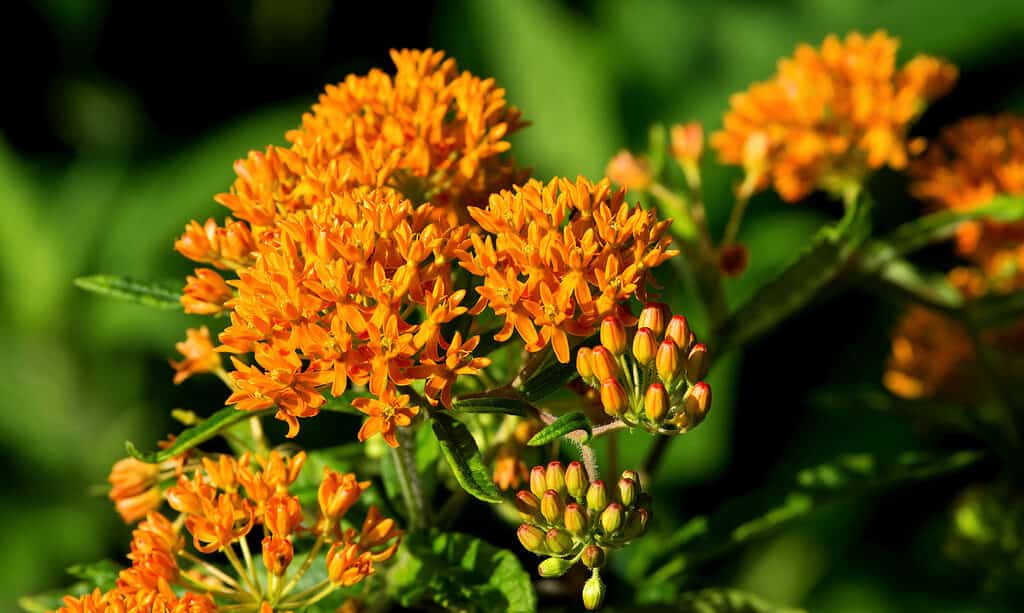
The butterfly weed usually grows to 1-3.5 feet tall.
©iStock.com/McKinneMike
| Butterfly Weed | |
|---|---|
| Scientific name | Asclepias tuberosa |
| Type of plant | Perennial |
| Distribution | Southwestern North America |
The butterfly weed is a milkweed species native to eastern and southwestern North America. It was named after the fact that butterflies are attracted to its vivid colors and copious nectar production.
The butterfly weed usually grows to 1-3.5 feet (0.3-1 m) tall. It features lanceolate leaves that are spirally arranged. It blooms from April to September; the flower heads are located in the upper axils of the plant. They are represented by umbels of about 3 inches (7.5 cm) in width, equipped with red, yellow, or orange flowers. Each flower features five sepals and five petals.
The species propagates through a 3-6-inch-long (7.5-15 cm) fruit pod filled with long-haired seeds.
4. White Trillium

The white trillium plant is often called white wake-robin, large-flowered trillium, or great white trillium.
©iStock.com/SHSPhotography
| White Trillium | |
|---|---|
| Scientific name | Trillium grandiflorum |
| Type of plant | Perennial |
| Distribution | Eastern North America, Southern United States, Iowa, Nova Scotia, Maine, southern Illinois |
The white trillium plant is often called white wake-robin, large-flowered trillium, or great white trillium. It is part of the Liliales order and is native mainly to eastern North America. Isolated specimens can be found in Iowa, Maine, and Nova Scotia.
You have the chance to spot this beautiful plant in mixed upland forests that are rich in vegetation. Don’t worry about not being able to spot it – its white flowers, featuring three petals each, can be seen from afar. They open in late spring and stay so until early summer.
The white trillium grows stems of 7.8-15.7 inches (20-40 cm) in height. Its flowers are about 1.5 to 3 inches (4-7 cm) long.
5. Bracken Fern

The bracken fern is a species native to North America and Eurasia.
©iStock.com/troyka
| Bracken Fern | |
|---|---|
| Scientific name | Pteridium aquilinum |
| Type of plant | Perennial |
| Distribution | North America, Eurasia |
The bracken fern, often referred to as brake, common bracken, or eagle fern is a species native to North America and Eurasia. However, Pteridium aquilinum is now considered a cosmopolitan plant due to its incredibly light spores.
Perennial but deciduous in winter, the plant is characterized by triangular fronds that stem from its underground rhizome. These fronds can attain heights of about 1-3 feet (0.3-1m). Since it features a rhizome, the plant often develops in dense colonies where each frond is identical from a genetic standpoint.
Although the bracken fern has no eye-catching feature, it can be easily spotted – a vivid green cluster of herbs with pointed, fern-typical leaves.
6. Ohio Buckeye
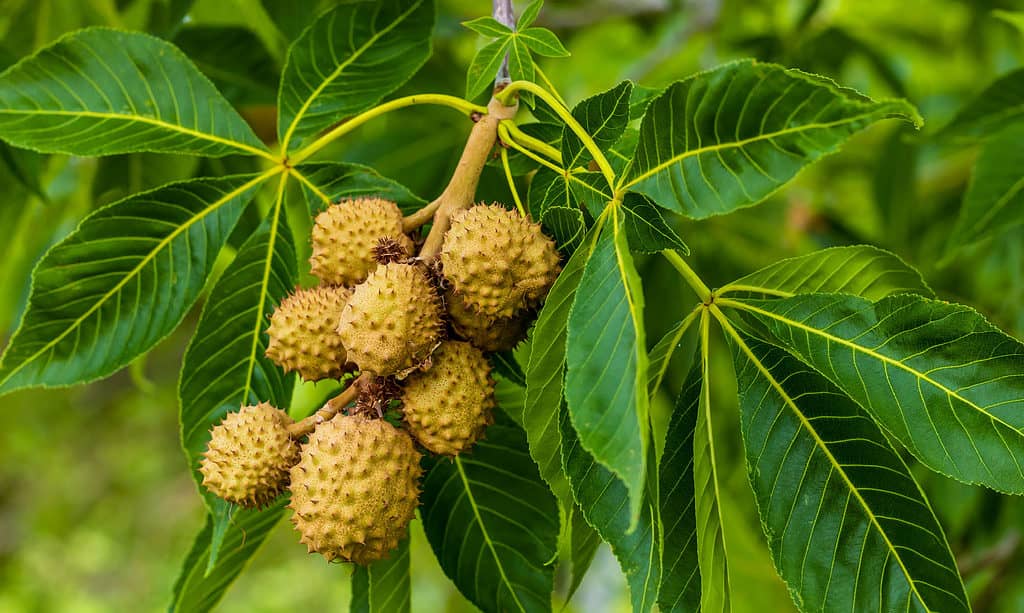
The Ohio buckeye is a soapberry tree native to different areas of North America.
©iStock.com/Faina Gurevich
| Ohio Buckeye | |
|---|---|
| Scientific name | Aesculus glabra |
| Type of plant | Perennial |
| Distribution | Midwestern and lower Great Plains regions, geological Black Belt, Ontario, Walpole Island |
The Ohio buckeye is a soapberry tree (part of the Sapindaceae family) native to different areas of North America. It can be spotted growing in mesic forests, streambanks, and along old field margins – it prefers growing in calcareous areas.
The Ohio buckeye is a rather high tree, growing up to 50-60 feet (15-18 m) tall. Its leaves can help you easily recognize it – they are about 3.1-6.3 inches (8-16 cm) long and quite broad. The flowers, even though they can be yellow, yellow-green, and even red, are harder to see as they’re only 0.79-1.18 inches (2-3 cm) long.
The fruit of the Ohio buckeye is a capsule that hosts a nut-like seed (which is poisonous to humans and cattle).
7. Yellow Buckeye
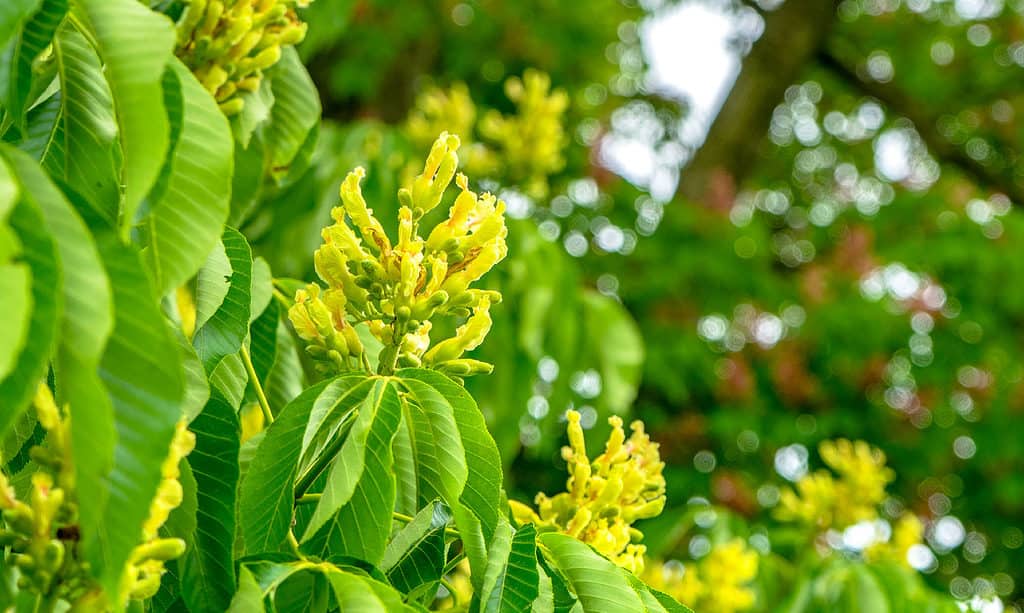
The yellow buckeye is a deciduous tree of the
Sapindaceaefamily.
©Cora Mueller/Shutterstock.com
| Yellow Buckeye | |
|---|---|
| Scientific name | Aesculus flava |
| Type of plant | Deciduous |
| Distribution | Ohio Valley, Appalachian Mountains |
The yellow buckeye, often called common or sweet buckeye, is a deciduous tree of the Sapindaceae family. This species can be found only in the Appalachian Mountains and Ohio Valley regions of the Eastern United States.
You can spot the yellow buckeye in mesophytic floodplains or forests (in soil characterized as circumneutral or acid). It grows taller than the Ohio buckeye – up to 65-154 feet (20-48 m).
Like its close relative, the Ohio buckeye, the yellow buckeye features small flowers that can be either yellow or yellow-green. Once again, its fruit is poisonous to humans, but a leaching process can make it edible.
8. White Snakeroot

White snakeroot is also known as the white sanicle or richweed.
©Nahhana/Shutterstock.com
| White Snakeroot | |
|---|---|
| Scientific name | Ageratina altissima |
| Type of plant | Perennial |
| Distribution | Eastern and central North America |
White snakeroot is also known as the white sanicle or richweed. It is part of the Asteraceae family and is known to be a poisonous herb. It is found throughout the eastern part of the United States, as well as in the mid-western part of Canada.
The white snakeroot can grow quite tall, up to 4.9 feet (1.5 m). It is an upright plant, meaning you won’t miss it if you’re purposely looking for it. The white flower heads form compound corymbs or flat-topped panicles. Each flower head is about 2-6 inches (5-15 cm) wide.
The plant contains tremetol, a toxin that usually ends up in cattle milk after the plant is consumed. People drinking the poisoned milk in large quantities frequently can develop milk sickness (tremetol poisoning).
9. Meadow Anemone
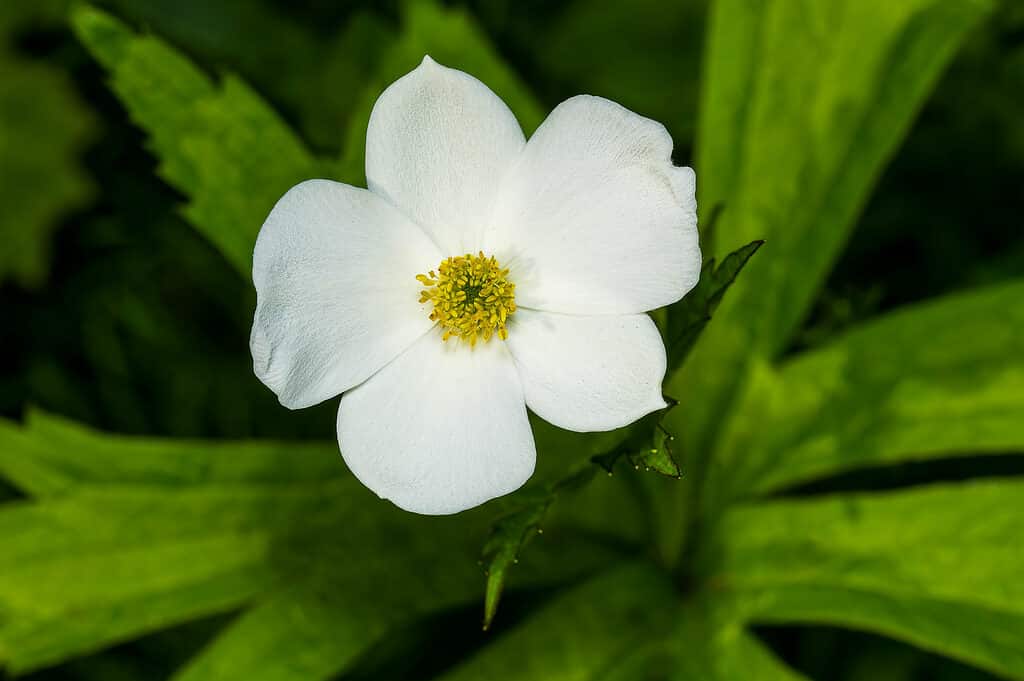
Meadow anemone flowers bloom from late spring to summer.
©Paul Reeves Photography/Shutterstock.com
| Meadow Anemone | |
|---|---|
| Scientific name | Anemonastrum canadense |
| Type of plant | Perennial |
| Distribution | North America |
Also known as the Canada anemone, round-leaf thimbleweed, windflower, or crowfoot, the meadow anemone can be found throughout North America, especially in thickets, meadows, lakeshores, and streambanks. It is known to spread quickly through its underground rhizomes.
You can easily spot the herb thanks to its shoots about 8-31 inches (20-80 cm) tall and rather wide leaves – 2-6 inches (5-15 cm) by 1.5-4 inches (4-10 cm). The plant is characterized by its white flowers, each equipped with five white sepals and up to 100 yellow stamens. Meadow anemone flowers bloom from late spring to summer.
Up Next:
- The Longest Biking Trail in Ohio
- 10 Great Hiking Mountains in Ohio
- 10 Amazing Waterfalls in Ohio (& Where To Find Them)
The photo featured at the top of this post is © iStock.com/mzurawski
Sources
- Wikipedia, Available here: https://en.wikipedia.org/wiki/Ohio#Geography
- Backyard Garden Lover, Available here: https://www.backyardgardenlover.com/ohio-native-plants-list/
- Gardenia, Available here: https://www.gardenia.net/native-plants/ohio?page=3
Thank you for reading! Have some feedback for us? Contact the AZ Animals editorial team.







